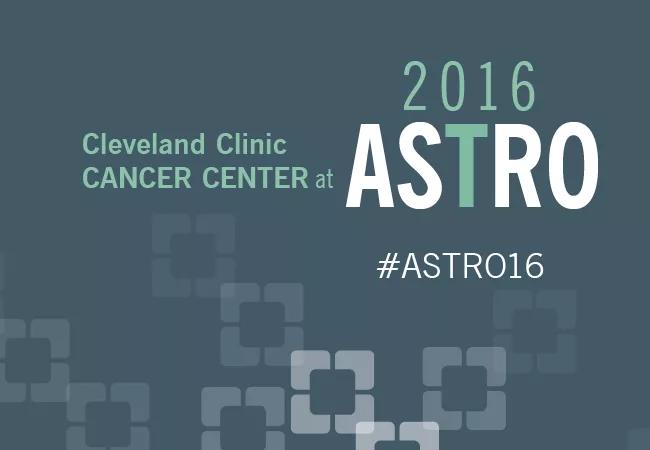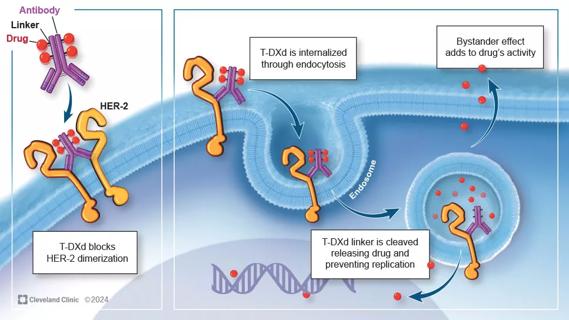Cleveland Clinic’s Radiation Oncology Staff Selects Highlights

The results of hundreds of important studies were presented at the recent 2016 American Society for Radiation Oncology (ASTRO) annual meeting.
Advertisement
Cleveland Clinic is a non-profit academic medical center. Advertising on our site helps support our mission. We do not endorse non-Cleveland Clinic products or services. Policy
Many Cleveland Clinic Cancer Center clinicians and researchers attended and presented at ASTRO’s September 25-28 sessions in Boston. Since then, we’ve discussed and debated which presentations we found most intriguing or that we feel have the greatest potential to change the practice of radiation oncology.
We’ve chosen the following as our Top 10 list of the noteworthy abstracts. Do you agree? Do you have other nominees? Let us know your thoughts in the comments section below.
Prostate Cancer
Commentary: This randomized trial of 1,092 men demonstrated that hypofractionated radiotherapy (70 Gy in 28 fractions) for low-risk prostate cancer offered patient-reported quality of life similar to that from conventionally fractionated radiation therapy (73.8 Gy in 41 fractions) at one year. In addition, tumor control rates were similar between the two regimens, suggesting that hypofractionation is an acceptable option for these patients. As a result, hypofractionated radiation therapy may offer a more convenient treatment option for men with prostate cancer and improve the value of external beam radiation therapy.
Brain Cancer
Commentary: This randomized trial demonstrated that the rates of neurocognitive decline with WBRT were lower than the increased rates of local failure with SRS. Of concern, the relapse rate was greater than 40 percent in the SRS arm, with no difference in survival between the two arms. Better long-term control of the resection cavity was noted with WBRT. It is unclear what is driving the worse-than-expected local control rates, given the higher local control rates from single-institution studies. We need further analysis of the drivers for poor local control and should consider additional research including the NRG proposed study of neoadjuvant SRS versus SRS following resection of brain metastases.
Advertisement
Breast Cancer
Commentary: Data from 4,376 patients with a minimum of 5 years follow-up were studied. This pooled analysis demonstrated a reduction in local recurrence, which is particularly important for patients with expected survival of 10 years or more and supports the use of boost in the setting of DCIS. No additional benefit with boost was seen for patients with a positive margin. This finding is consistent with recently published guidelines.
Prostate Cancer
Commentary: This study pooled data on more than 2,400 patients from 10 academic institutions to assess factors predictive of mortality after salvage treatment following prostatectomy. Factors including Gleason score, extraprostatic extension, seminal vesicle invasion, surgical margins and use of androgen deprivation therapy were assessed. After radical prostatectomy, salvage radiotherapy delivered at lower postoperative prostate-specific antigen levels was associated with decreased rates of prostate cancer-specific and overall mortality. Higher Gleason score, seminal vesicle invasion and treatment era were also independently predictive of outcomes.
Prostate Cancer
Advertisement
Commentary: For men with favorable intermediate-risk prostate cancer, brachytherapy alone resulted in tumor control at 5 years similar to that from the combination of external beam radiation therapy and brachytherapy. In addition, patients treated with brachytherapy alone had fewer side effects than those receiving combination therapy. For patients with intermediate-risk prostate cancer, brachytherapy without the combination of external beam radiation therapy should be considered a treatment option.
Lung Cancer
Commentary: This randomized phase II study of patients receiving definitive-intent SBRT for peripheral stage I non-small cell lung cancer < 5 cm established single-fraction SBRT (30 Gy in 1 fraction) as an acceptable alternative to the RTOG 0236 regimen of 60 Gy in 3 fractions. With 98 eligible patients randomized and 24-month median follow-up, there was no difference in tumor control or treatment-related toxicity between the two regimens. Along with previous results of RTOG 0915 (34 Gy in 1 fraction versus 48 Gy in 4 fractions), this establishes single-fraction SBRT as a validated, trial-based regimen for peripheral NSCLC.
Cervical and Endometrial Cancer
Advertisement
Commentary: This randomized trial compared 3-D conformal radiation therapy (3-D CRT) to intensity-modulated radiation therapy (IMRT) in women with cervical and endometrial cancer after hysterectomy. The initial analysis showed a significant improvement in patient-reported acute gastrointestinal toxicity during treatment in the IMRT arm compared with the conventional arm, which was the primary endpoint in the study. It also showed improved quality-of-life scores in women treated with IMRT by the end of the treatment. Longer follow-up is needed, however, to determine if late toxicity outcomes will be improved in patients treated with IMRT compared with 3-D CRT.
Brain and Spinal Cancer
Commentary: This is a report on meningioma patients categorized as low-risk (Group I) as observed after surgery. These patients had a newly diagnosed gross totally resected (Simpson’s grade I, II, or III resection with no residual nodular enhancement on postoperative imaging) or subtotally resected (residual nodular enhancement or Simpson grade IV or V excision) World Health Organization (WHO) grade I meningioma. Results support surgery followed by observation for patients with newly diagnosed WHO grade 1 meningioma following gross total resection with a 3-year progression-free survival > 90 percent. The results, however, raise questions about management of patients following subtotal resection, a subcohort that may benefit from early radiation therapy given a 40 percent crude 5-year local failure rate.
Advertisement
Lymphoma
Commentary: As > 50 percent of patients with stage I-II low-grade follicular lymphoma may relapse (predominantly outside the radiation field), this trial evaluated the addition of systemic therapy to radiation treatment. The standard paradigm of IFRT for early-stage (I-II) low-grade follicular lymphoma with the addition of multi-agent chemotherapy demonstrated a benefit in progression-free survival with the addition of systemic therapy to IFRT.
Brain cancer
Commentary: Radiation dose and treatment volume reduction were tested in this study. This trial supports IFRT boost as standard of care for children with average-risk medulloblastoma, instead of treatment to the entire posterior fossa. However, it also found that reduced-dose CSI to 18 Gy should not be used as standard of care due to higher rates of failure. Involved-field boost was not associated with worse outcomes compared with whole posterior fossa boost.
Advertisement

First-of-its-kind research investigates the viability of standard screening to reduce the burden of late-stage cancer diagnoses

Study demonstrates ability to reduce patients’ reliance on phlebotomies to stabilize hematocrit levels

Findings highlight an association between obesity and an increased incidence of moderate-severe disease

Cleveland Clinic Cancer Institute takes multi-faceted approach to increasing clinical trial access 23456

Key learnings from DESTINY trials

Gene editing technology offers promise for treating multiple myeloma and other hematologic malignancies, as well as solid tumors

Study of 401,576 patients reveals differences in cancer burdens as well as overall survival

Enfortumab plus pembrolizumab reduced risk of death by 53% compared with platinum-based chemotherapy